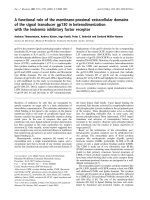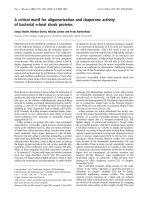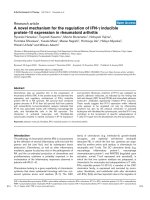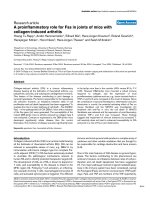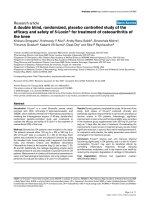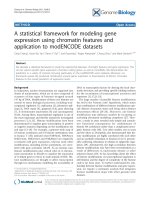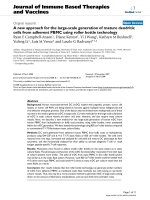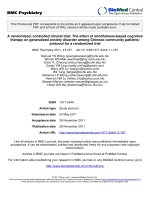Báo cáo y học: "A proinflammatory role for Fas in joints of mice with collagen-induced arthritis" docx
Bạn đang xem bản rút gọn của tài liệu. Xem và tải ngay bản đầy đủ của tài liệu tại đây (423.47 KB, 11 trang )
Open Access
Available online />R404
Vol 6 No 5
Research article
A proinflammatory role for Fas in joints of mice with
collagen-induced arthritis
Hoang Tu-Rapp
1
, André Hammermüller
1
, Eilhard Mix
2
, Hans-Jürgen Kreutzer
3
, Roland Goerlich
4
,
Hansjürgen Köhler
1
, Horst Nizze
3
, Hans-Jürgen Thiesen
1
and Saleh M Ibrahim
1
1
Department of Immunology, University of Rostock, Rostock, Germany
2
Department of Neurology, University of Rostock, Rostock, Germany
3
Department of Pathology, University of Rostock, Rostock, Germany
4
Institute of Biology VII, RWTH Aachen, Aachen, Germany
Corresponding author: Hoang Tu-Rapp,
Received: 11 Feb 2004 Revisions requested: 3 Mar 2004 Revisions received: 30 Apr 2004 Accepted: 7 Jun 2004 Published: 19 Jul 2004
Arthritis Res Ther 2004, 6:R404-R414 (DOI 10.1186/ar1205)
http://arthr itis-research.com/conte nt/6/5/R404
© 2004 Tu-Rapp et al.; licensee BioMed Central Ltd. This is an Open Access article: verbatim copying and redistribution of this article are permitted
in all media for any purpose, provided this notice is preserved along with the article's original URL.
Abstract
Collagen-induced arthritis (CIA) is a chronic inflammatory
disease bearing all the hallmarks of rheumatoid arthritis, e.g.
polyarthritis, synovitis, and subsequent cartilage/bone erosions.
One feature of the disease contributing to joint damage is
synovial hyperplasia. The factors responsible for the hyperplasia
are unknown; however, an imbalance between rates of cell
proliferation and cell death (apoptosis) has been suggested. To
evaluate the role of a major pathway of cell death – Fas (CD95)/
FasL – in the pathogenesis of CIA, DBA/1J mice with a mutation
of the Fas gene (lpr) were generated. The susceptibility of the
mutant DBA-lpr/lpr mice to arthritis induced by collagen type II
was evaluated. Contrary to expectations, the DBA-lpr/lpr mice
developed significantly milder disease than the control
littermates. The incidence of disease was also significantly lower
in the lpr/lpr mice than in the controls (40% versus 81%; P <
0.05). However DBA-lpr/lpr mice mounted a robust immune
response to collagen, and the expression of local
proinflammatory cytokines such as, e.g., tumor necrosis factor α
(TNF-α) and IL-6 were increased at the onset of disease. Since
the contribution of synovial fibroblasts to inflammation and joint
destruction is crucial, the potential activating effect of Fas on
mouse fibroblast cell line NIH3T3 was investigated. On
treatment with anti-Fas in vitro, the cell death of NIH3T3
fibroblasts was reduced and the expression of proinflammatory
cytokines TNF-α and IL-6 was increased. These findings
suggest that impairment of immune tolerance by increased T-
cell reactivity does not lead to enhanced susceptibility to CIA
and point to a role of Fas in joint destruction.
Keywords: apoptosis, Fas, rheumatoid arthritis, tolerance
Introduction
Collagen-induced arthritis (CIA) is an animal model bearing
all the hallmarks of rheumatoid arthritis (RA). CIA can be
induced in susceptible strains of mice, e.g. DBA/1J, by
immunization with bovine collagen type II in complete Fre-
und's adjuvant (CFA) [1]. CIA has been extensively studied
to elucidate the pathological mechanisms relevant to
human RA and to identify potential therapeutic targets [2].
The development of CIA, as of RA, is known to depend on
T cells, and susceptibility to the disease is linked to the
MHC region [3]. Following T-cell activation, an inflamma-
tory cascade involving T cells, macrophages/monocytes, B
cells, and activated synoviocytes is triggered. The different
immune and local synovial cells produce a complex array of
cytokines and other soluble mediators that are thought to
be responsible for cartilage destruction and bone erosion
[4-6].
One of the main features of CIA disease is synovial hyper-
plasia. The factors contributing to this phenomenon are
unknown; however, an imbalance between rates of cell pro-
liferation and cell death (apoptosis) has been suggested
[7]. Two major pathways involved in ligand-mediated apop-
tosis in the immune system have been considered, namely
the Fas ligand (FasL) and tumor necrosis factor (TNF) path-
ways. FasL and TNF are members of the TNF superfamily.
AICD = activation-induced cell death; CFA = complete Freund's adjuvant; CIA = collagen-induced arthritis; ConA = concanavalin A; ELISA = enzyme-
linked immunosorbent assay; Fab = antigen-binding fragment; FACS = fluorescence-activated cell sorter; FasL = Fas ligand; FITC = fluorescein iso-
thiocyanate; IFN = interferon; IL = interleukin; mAb = monoclonal antibody; PBS = phosphate-buffered saline; PCR = polymerase chain reaction; PE
= phycoerythrin; RA = rheumatoid arthritis; RPMI = Roswell Park Memorial Institute [medium]; TNF = tumor necrosis factor.
Arthritis Research & Therapy Vol 6 No 5 Tu-Rapp et al.
R405
Both cell-death pathways have been shown to contribute to
peripheral tolerance and to the maintenance of homeosta-
sis in the immune system through activation-induced cell
death (AICD) [8-11]. Additionally, FasL together with per-
forin and TNF are the main pathways for killer cells, and
mutations in those molecules block cytotoxicity of target
cells [12,13]. Thus, cell-death pathways could contribute
to the pathology of arthritis in at least two ways: through
promotion of autoimmunity by blocking tolerance of autore-
active lymphocytes and AICD, or through destruction of tar-
get tissues by induction of apoptosis or proliferation in
susceptible cells.
A pathogenic role of TNF-α for arthritis is well documented
in a number of studies and is supported by the success of
anti-TNF therapy. Murine studies using TNF-receptor
knockout mice and TNF transgenic mice point to a primary
role in the local proliferation of synovial fibroblasts rather
than to tolerance impairment of lymphocytes or death of
local joint cells [14,15].
Although the exact role of Fas in arthritis remains unclear,
some observations suggest an involvement of this receptor
molecule in the disease process. It has been reported that
a subset of T cells in patients with RA was resistant to Fas-
mediated apoptosis [16,17]. Mysler and co-workers and
other groups showed that T cells in systemic lupus ery-
thematosus have an abnormal increase in surface Fas
expression [18,19]. However, they showed proliferative
and activating response to Fas crosslinking [20] rather than
enhanced susceptibility to Fas-mediated apoptosis. Sev-
eral studies demonstrated that autoreactive lymphocytes
infiltrating the rheumatoid synovium are resistant to apopto-
sis either because of expression of the anti-apoptotic pro-
teins bcl2 and bclxl or because of deficiency of FasL. On
the other hand, conflicting evidence showing that infiltrat-
ing T cells are Fas-sensitive has been presented [16,21-
24]. Synovial fibroblasts were shown to be susceptible to
apoptosis induced by anti-Fas antibody, but they were
shown by others to express high levels of oncogenes and
bcl2 as well [24].
In this study, we attempted to evaluate the role of the Fas
cell-death pathway in the pathogenesis of CIA by generat-
ing DBA/1J mice with a mutation of the Fas gene (DBA-lpr/
lpr) and by examining the effect of the mutation on the
immune response to collagen and on joint pathology.
Materials and methods
Mice, backcrossing, antigen, immunization, and
assessment of arthritis
DBA/1J mice were obtained from Harlan-Winkelmann
(Borchen, Germany) and kept under standard conditions at
the animal facility of the University of Rostock. Fas mutant
mice were obtained from Bomholtgard A/S (Ry, Denmark).
These mice were not available on the DBA/1J background
and, therefore, were obtained as C3H-lpr. The lpr mutation
was then backcrossed onto the DBA/1J background. The
mice were propagated as hemizygous mutants for at least
six generations and the mutation was followed by PCR
analysis of tail DNA, as previously described [10]. Experi-
mental mice were generated by brother–sister mating and
homozygosity was assessed by PCR as described else-
where [10].
Eight-week-old mice were immunized intradermally at the
base of the tail with 150 µg of bovine collagen II (Sigma,
Deisenhofen, Germany) emulsified in CFA (Difco, Detroit,
MI, USA). Mice were boosted with 150 µg of collagen in
incomplete Freund's adjuvant at day 21. Clinical scores
were assessed immediately before immunization (day 0)
and thereafter three times weekly until day 75 after immuni-
zation. Inflammation of the four paws was scored as fol-
lows: 0, no inflammation; 1, swelling/redness of one joint;
2, swelling/redness of more than one joint or mild inflamma-
tion of the whole paw; 3, severe inflammation of whole paw
or ankylosis. For evaluating the susceptibility of mice to
CIA, the incidence of disease (number of diseased mice
divided by total number of mice), the mean score (total
score of diseased mice divided by total number of mice),
and the mean day of onset of disease (total days of onset
divided by the number of diseased mice) were calculated.
The study was approved by the appropriate authorities of
the state of Mecklenburg-Vorpommern, Germany.
Cell culture, T-cell proliferation assays, and cytokine
induction
Cells and cell culture
Draining lymph nodes were removed under aseptic condi-
tions. Single-cell suspensions of mononuclear cells of
pooled lymph nodes from individual mice were prepared.
The cells were washed three times in culture medium
before being suspended at 2 × 10
6
mononuclear cells per
milliliter in round-bottomed, 96-well polystyrene microtiter
plates (Nunc, Copenhagen, Denmark) in a total volume of
200 µl. The culture medium consisted of RPMI 1640 with
Glutamax-II (Gibco BRL, Life Technologies, Karlsruhe, Ger-
many) supplemented with 50 IU/ml penicillin, 60 µg/ml
streptomycin, and 5% inactivated fetal bovine serum (all
from Gibco BRL). For lymphocyte stimulation, 10 µl aliq-
uots of collagen II were added to cultures at a final concen-
tration of 10–50 µg/ml or 10 µl of concanavalin A (ConA)
(Difco) at a final concentration of 4 µg/ml. These concen-
trations had optimal stimulatory effects as assessed in pre-
vious experiments. Cells were incubated at 37°C in
humidified air with 5% CO
2
for 72 hours. Cultures were
done in triplicate for proliferation assays and in duplicate for
ELISA measurements of IFN-γ. NIH3T3 fibroblasts were
cultured in Dulbecco's modified Eagle's medium containing
50 IU/ml penicillin, 60 µg/ml streptomycin, and 5%
Available online />R406
inactivated fetal bovine serum. To determine their suscepti-
bility to Fas-induced cell death, purified hamster antimouse
Fas monoclonal antibody, clone Jo2 (Becton Dickinson,
Heidelberg, Germany), was used. NIH3T3 cells were incu-
bated with 50 ng Jo2/ml or 50 ng Jo2/ml and 1 µg protein
G/ml, respectively, for 24 hours.
Proliferation assay
After 60 hours of incubation, cells were pulsed with 10 µl
[
3
H]methylthymidine (1 µCi/ml) (Amersham Pharmacia Bio-
tech, Freiburg, Germany) and cultured for an additional 12
hours. Cells were harvested onto fiberglass filters (Titertek,
Skatron, Lierbyen, Norway). [
3
H]thymidine incorporation
was measured in a liquid β-scintillation counter. The results
were expressed as counts per minute.
ELISA for measurement of IFN-
γ
After 72 hours of incubation, supernatants were collected
from the lymph node cell cultures and frozen in two aliquots
at -80°C. Concentrations of IFN-γ in the supernatants were
determined by the Cytoscreen Immunoassay Kit (Bio-
Source, Camarillo, CA, USA) in accordance with the man-
ufacturer's instructions.
Anticollagen antibody assay
Sera were collected from control DBA-lpr/+ and mutant
DBA-lpr/lpr mice before immunization and at days 20 and
47 after immunization and a standard ELISA was used to
measure total anticollagen II IgG. In brief, ELISA plates
(Greiner, Frickenhausen, Germany) were coated with 5 µg/
ml collagen II and incubated overnight at 4°C. The plates
were then washed three times with washing buffer (1 ×
phosphate-buffered saline [PBS], 1% bovine serum albu-
min, 0.05% Tween 20) and blocked for 1 hour at room tem-
perature. Sera were added to the plates after washing at
dilutions of 1:10, 1:50, 1:500, 1:5000, and 1:50,000. After
incubation for 2 hours at 37°C, the plates were washed and
biotin-conjugated AffiniPure rabbit antimouse IgG (Dian-
ova, Hamburg, Germany), diluted 1:20,000 was added and
incubated for 1 hour at 37°C. This step was followed by
washing and incubation with a 1:1000 dilution of alkaline-
phosphatase-conjugated streptavidin (Dianova). Plates
were developed by the addition of a substrate and read at
wavelength 405 nm. Negative and positive controls were
washing buffer and the supernatant of the anticollagen anti-
body hybridoma CIIC1 (a gift from Dr R Holmdahl, Univer-
sity of Lund, Sweden) respectively. The measurements
were made in triplicate.
Histopathological analysis of joints
Histopathological features of peripheral joints were
assessed in hematoxylin-stained formalin-fixed paraffin-
embedded sections as described previously [25].
Flow cytometry
The following antibodies were used to study surface
expression of CD4, CD8, CD45, CD90, Fas (CD95), and
CD44 on lymphocytes: respectively, clone H129.19, clone
53–6.7, clone RA3-6B2, clone 30-H12, clone Jo2, and
clone IM7. All antibodies were purchased from Becton
Dickinson. Staining was essentially done following the
manufacturer's instructions. In brief, lymph node cells were
isolated as described above, washed twice in PBS, and
incubated for 20 minutes on ice in 100 µl of FACS (fluores-
cence-activated cell sorter) buffer (1 × PBS, 0.1% bovine
serum albumin, 0.1% sodium acid) in the presence of the
FITC- or PE-labeled specific antibodies. Isotype controls
were used at the appropriate concentrations. The dead
cells were quantified by staining with propidium iodide in
accordance with the instructions provided by the manufac-
turer (Becton Dickinson). Flow cytometric analysis was per-
formed on the FACScan (Becton Dickinson).
RNA isolation and cDNA synthesis
Paws were dissected at time points around the onset of
disease and during its chronic stage and snap frozen in liq-
uid nitrogen, and total RNA was extracted with the RNeasy
Mini Kit (Qiagen, Hilden, Germany) in accordance with the
manufacturer's instructions. Samples were treated with
RNase-free DNase (Qiagen) on the RNeasy columns in
accordance with the manufacturer's instructions. RNA was
finally dissolved in 100 µl of RNase-free water.
For reverse transcription, we used 300 U of SUPER-
SCRIPT™ RNase H Transcriptase with the supplied buffer
(Gibco BRL), 20 U of RNasin, 3 µM random hexamers
(Amersham Pharmacia Biotech), deoxynucleoside triphos-
phate, dithiothreitol, and 2 µg of RNA sample per 25 µl
reaction volume. The samples were heated for 2 hours at
42°C and rapidly cooled on ice.
TaqMan
®
Real-Time PCR
The TaqMan
®
PCR Core Reagent Kit (Applied Biosystems,
Weiterstadt, Germany) was used for amplification of tar-
gets. For PCR of IL-6 and TNF-α, we used ready-made Pre-
Developed TaqMan
®
Assay Reagents and the TaqMan
®
7700 instrument (Applied Biosystems). The reaction condi-
tions for 50 ng cDNA were as follows: 2 min at 50°C, 10
min at 95°C, 45 repeats of 15 s at 95°C, and 1 min at 60°C.
For each RNA isolation, measurements of gene expression
were done three times, and the mean of these values was
used for further analysis. In accordance with the manufac-
turer's User Bulletin #2 (Applied Biosystems), the compar-
ative C
t
method and the internal control (glyceraldehyde-3-
phosphate dehydrogenase) were used to normalize the
expression levels of target genes.
Arthritis Research & Therapy Vol 6 No 5 Tu-Rapp et al.
R407
Figure 1
The lpr phenotype is mild in the DBA/1J genetic backgroundThe lpr phenotype is mild in the DBA/1J genetic background. Analysis of surface expression of CD4/CD8 (a, b), CD90/CD45 (c, d), and Fas
(CD95) (e, f) on T lymphocytes purified from lymph nodes of 24-week-old DBA/1J-lpr/lpr mice (b, d, f) and DBA/1J littermates (a, c, e). Lymph node
cells were stained with the indicated antibodies (Becton Dickinson). For analysis of CD95 (open area), an isotype control (shadowed area) is shown
(e, f). Samples were analyzed on a FACScan cell sorter (Becton Dickinson).
(c)
(e)
(a)
CD4
CD90
CD8CD45
Cell Number
Fas
(f)
(b)
(d)
Available online />R408
Statistical analysis
Statistical differences between experimental and control
groups were analyzed using the Mann–Whitney U test for
the severity of arthritis, the χ
2
test for incidence of arthritis,
and Student's t-test for day of disease onset, antibody lev-
els, and T-cell responses. A P value of <0.05 was consid-
ered significant.
Results
The DBA/1J genetic background does not influence the
lpr phenotype
To obtain CIA-susceptible Fas mutant mice, we back-
crossed the lpr mutation onto the susceptible DBA/1J
background for at least six generations. Successful back-
crossing to the DBA background was assessed by PCR
analysis of the MHC-H2 locus (data not shown). Older (24-
week-old) DBA-lpr/lpr mice showed a typical lpr phenotype
of accumulation of CD4
-
/CD8
-
doubly negative CD3
+
T
cells (Fig. 1b) and CD45
+
/CD90
+
doubly positive cells
(Fig. 1d) in the periphery; however, they did not develop
spontaneous arthritis (data not shown). As expected, DBA-
lpr/lpr thymocytes were resistant to anti-Fas-induced apop-
tosis (data not shown) and only a very low level of Fas was
detected on their surface – a finding that is consistent with
an earlier observation by others that lpr/lpr mice express
very low levels of Fas (Fig. 1f).
Mice used for further experiments were 8 weeks old and
they had a normal distribution of T-cell subpopulation, com-
parable to that in wild-type control DBA/1J mice.
Fas mutation does not enhance the severity or increase
the incidence of disease
To assess the effect of the lpr mutation on arthritis develop-
ment, we induced the disease in 8-week-old DBA-lpr/lpr
mice and their heterozygous control littermates. Contrary to
expectations, the lpr mutation led to a decrease in the
severity and incidence of disease. Table 1 shows lower
mean disease scores at day 64 after immunization in lpr/lpr
mice than in control mice (P < 0.05). The incidence of dis-
ease was significantly lower in lpr/lpr mice than in their con-
trols. The mean onset of disease was slightly later in the lpr/
lpr mice than in their controls, but no statistical significance
was achieved. Despite the mild disease in the lpr/lpr group,
individual mice of both genotypes had either severe, very
mild, or no disease manifestations. Histopathological differ-
ences reflected the clinical severity of disease. No evi-
dence of arthritic disease was observed the day before
immunization (Fig. 2a,2b). At the inflamed stage of disease
(score 3), both groups showed characteristic features of
inflammation, such as fibroblast proliferation, cartilage
degeneration, granulomatous lesions in the sublining tis-
sues, and erosion of bone (Fig. 2c,2d); however,
decreased cell proliferation and lymphocyte infiltration and
erosion of cartilage and bone were generally observed in
the DBA-lpr/lpr mice (Fig. 2c).
DBA-lpr/lpr mice mount a robust immune response to
collagen
To determine whether the mild clinical symptoms reflected
a failure to mount an adequate immune response to colla-
gen II, we analyzed the T- and B-cell responses in
homozygous DBA-lpr/lpr and heterozygous DBA-lpr/+
mice. Specifically, we analyzed the collagen-II-specific T-
cell proliferation (Fig. 3a) and IFN-γ production (Fig. 3b) in
vitro and anticollagen IgG antibody titers in sera of immu-
nized mice (Fig. 4).
Cultured cells from draining lymph nodes were restimu-
lated in vitro with collagen II or ConA 7 days after immuni-
zation. The control lymph node cells and lpr/lpr cells
proliferated equally well in response to ConA (data not
shown). A significantly higher proliferative T-cell response
to collagen II was observed in DBA-lpr/lpr mice than in
control mice (Fig. 3a). In agreement with these results, IFN-
γ production after antigen stimulation was higher in DBA-
lpr/lpr than in DBA-lpr/+ littermates (Fig. 3b). To show
whether the enhanced immune response was due to an
increased frequency of memory phenotype of lpr T cells
upon stimulation with collagen, phenotypic analysis of sur-
face expression of CD44 on T lymphocytes was performed.
No change of memory cell populations after stimulation
was observed (Fig. 3c).
Furthermore, no significant differences were seen between
the two genotypes in the levels of anticollagen II antibody
titer at day 20, or in the chronic phase, at day 47. However
nonimmunized DBA-lpr/lpr mice showed significantly
Table 1
DBA-lpr/lpr mice are protected against collagen-induced arthritis
No. of mice
a
Incidence (%)
b
Mean score
c
at day 64 Mean day of onset
d
DBA/1J-lpr/lpr 34 44*
e
1.6 ± 0.75*
f
51 ± 14
DBA/1J-lpr/+ 33 81 5 ± 1.1 41 ± 6
DBA/1J-lpr/lpr and DBA/1J-lpr/+ mice were scored for arthritic lesions as described in Materials and methods. A summary of disease course in
DBA/1J-lpr/lpr and their control littermates DBA/1J-lpr/+ is shown.
a
18 of the lpr/lpr mice and 16 of the lpr/+ mice are from Ma and co-workers
[45].
b
Number of diseased mice divided by all mice.
c
Score of diseased mice divided by all mice ± SEM.
d
Total of days of onset divided by the
number of diseased mice ± SD. *
e
P < 0.05, χ
2
test. *
f
P < 0.05, Mann–Whitney U test.
Arthritis Research & Therapy Vol 6 No 5 Tu-Rapp et al.
R409
Figure 2
Histopathological analysis of joints from experimental and control mice before and after induction of collagen-induced arthritisHistopathological analysis of joints from experimental and control mice before and after induction of collagen-induced arthritis. Healthy (a, b) and
inflamed joints (c, d) from DBA-lpr/lpr mice (a, c) and their littermate controls (b, d). The inflamed paws had a disease score of 3. The paraffin sec-
tions were stained with hematoxylin and eosin. B, bone; C, cartilage; P, pannus; SL, synovial lining. Bars in the figure represent 200 µm (a, c, d) and
100 µm (b), respectively.
(a) (b)
(c) (d)
Available online />R410
higher levels of anticollagen antibodies than DBA-lpr/+
control mice, in which almost no antibodies were detected
(Fig. 4a).
Protection against CIA is not due to down-regulation of
proinflammatory cytokines in joints
Since cytokines such as TNF-α and IL-6 are critical media-
tors of inflammation, we investigated the effect of Fas on
the expression of proinflammatory cytokines in joints. The
paws were harvested both at the onset of disease (4 and 7
weeks after immunization) and at the chronic stage of dis-
ease (10–12 weeks after immunization), and mRNA
expression of cytokines was measured. In spite of mild
arthritis in DBA-lpr/lpr mice, the expression of TNF-α and
IL-6 was significantly higher than that in joints of DBA-lpr/+
mice at the onset of arthritis (P < 0.001) (Fig. 5a,5b). The
mRNA expression of these cytokines was higher in joints of
DBA-lpr/lpr mice than that in joints of DBA-lpr/+ mice at the
chronic stage of disease, too; however no significant differ-
ences were observed (Fig. 5c,5d).
Fas ligation blocks cell death and enhances expression
of proinflammatory cytokines
Since synovial hyperplasia contributes to the pathogensis
of CIA, we examined the potential stimulatory effect of anti-
Fas monoclonal antibodies (mAb; clone Jo2) on synovial
fibroblasts using the mouse fibroblast cell line NIH3T3. Fas
is expressed in NIH3T3 (data not shown). The cells were
cultured with anti-Fas mAb or protein G. Cell death was
measured by staining with propidium iodide.
We found that anti-Fas mAb reduced cell death in NIH3T3
fibroblasts (Fig. 6a). Cell death was significantly decreased
Figure 3
DBA-lpr/lpr mice mount a robust T-cell response to collagenDBA-lpr/lpr mice mount a robust T-cell response to collagen. DBA-lpr/
lpr lymphocytes show increased proliferation (a) and increased IFN-γ
production (b) in response to in vitro stimulation by collagen II. Draining
lymph nodes were obtained from DBA-lpr/lpr (white bars; n = 3) and
control DBA-lpr/+ (filled bars; n = 3) mice 7 days after immunization
with collagen II and complete Freund's adjuvant. For measurement of
cell proliferation, the cells were cultured for 60 hours with collagen II at
the indicated concentrations, and then pulsed with [
3
H] thymidine. Con-
centrations of IFN-γ in the supernatant were determined by ELISA. The
columns represent mean values and the error bars indicate standard
deviations. Differences were statistically significant in all comparisons
(*P < 0.05; **P < 0.001). The enhanced T-cell response is not due to
changed subpopulations. (c) Phenotypic analysis of surface expression
of CD44 on nonstimulated (cC) and stimulated (cB, cD) T lymphocytes
purified from lymph nodes of homozygotes (DBA/1J-lpr/lpr) (bright line)
and their heterozygote (DBA/1J-lpr/+) littermates (dark line). Lymph
node cells were stimulated with concanavalin A (cB) and bovine colla-
gen II (cD). The isotype control is shown as shadowed area. The sam-
ples were analyzed on a FACScan (Becton Dickinson) and gated on
lymphocytes (cA).
0
5000
10000
15000
20000
25000
30000
35000
100 10 1 Medium
Collagen (µg/ml)
3H-Thymidin (cpm
**
**
*
0
200
400
600
800
1000
1200
1400
1600
100.0 10.0 1.0
Collagen (µg/ml)
IFN-gamma (pg/ml
)
**
**
*
(c)
(a)
(b)
Figure 4
Changes in the development of arthritis are not due to changes in B-cell functionChanges in the development of arthritis are not due to changes in B-
cell function. Titers of collagen-specific IgG antibodies were deter-
mined in sera of DBA-lpr/lpr mice (n = 15) and DBA-lpr/+ control mice
(n = 11) before immunization (a) and at 20 days (b) and 47 days (c)
after immunization with collagen in complete Freund's adjuvant. Hori-
zontal lines indicate medians. Significant differences between the two
groups were seen only at day 0 (*P < 0.05).
(a) (b) (c)
10
100
1000
10000
10
100
1000
10000
10
100
1000
10000
10
100
1000
10000
10
100
1000
10000
10
100
1000
10000
lpr -/-
day 0
Titer
lpr -/-
day 20
lpr +/-
day 0
lpr -/-
day 47
lpr +/-
day 47
lpr +/-
day 20
*
l
p
r/l
pr
l
p
r/+ l
p
r/l
pr
l
p
r/+ l
p
r/l
pr
l
p
r/+
day 0 day 0 day 20 day 20 day 47 day 47
Arthritis Research & Therapy Vol 6 No 5 Tu-Rapp et al.
R411
(P < 0.01) by treatment with anti-Fas mAb. The additional
treatment with protein G causing the trimerization of Fas
still resulted in significantly decreased cell death (P <
0.05). Furthermore, treatment with anti-Fas mAb caused a
significantly (P < 0.05) increased expression of TNF-α and
Figure 5
Protection against collagen-induced arthritis (CIA) is not due to down-regulation of proinflammatory cytokinesProtection against collagen-induced arthritis (CIA) is not due to down-
regulation of proinflammatory cytokines. Relative expression of tumor
necrosis factor (TNF)-α (a, c) and IL-6 mRNA (b, d) in joints of DBA-lpr/
lpr (white bars) and DBA-lpr/+ (filled bars) mice at the onset of disease
(a, b) and at the chronic level of disease (c, d), as determined by real-
time PCR. For measurement at the onset, the paws of the DBA-lpr/+
mice (n = 14) were harvested at 4 weeks. Those from DBA-lpr/lpr mice
were harvested at 4 (n = 10) and 7 (n = 9) weeks; these were pooled
for analysis, because they did not differ. For measurements during the
chronic phase, paws of DBA-lpr/lpr (n = 9) and DBA-lpr/+ (n = 10)
mice were harvested at 10–12 weeks. Significant differences were
seen between the two groups at the onset of disease (*** P < 0.001).
(a)
0
10000
20000
30000
40000
50000
60000
DBA-lpr/lpr DBA-wt
TNF-alpha
***
(b)
0
2000
4000
6000
8000
10000
12000
14000
DBA-lpr/lpr DBA-wt
IL-6
***
(c)
0
5000
10000
15000
20000
25000
30000
35000
DBA-lpr/lpr DBA-wt
TNF-alpha
(d)
0
1000
2000
3000
4000
5000
DBA-lpr/lpr DBA-wt
IL-6
DBA-lpr/lpr DBA-lpr/+
DBA-lpr/lpr DBA-lpr/+
DBA-lpr/lpr DBA-lpr/+
DBA-lpr/lpr DBA-lpr/+
Figure 6
Fas ligation blocks cell death and enhances expression of proinflamma-tory cytokinesFas ligation blocks cell death and enhances expression of proinflamma-
tory cytokines. Fas-induced cell death of NIH3T3 fibroblasts (n = 3)
measured by fluorescence-activated cell sorting (a) and the relative
expression of tumor necrosis factor (TNF)-α (b) and IL-6 (c) mRNA in
NIH3T3 fibroblasts (n = 3), determined by real-time PCR. Cells (1 ×
10
6
/ml) were stimulated with 50 ng anti-Fas antibody/ml or 50 ng anti-
Fas antibody/ml and 1 µg protein G for 24 hours. Control cells were
incubated with medium only. AB, antibody.
0
10
20
30
40
50
60
70
anti-Fas AB anti-Fas AB +
Protein G
control
cell death (%
)
*
**
-1000000
1000000
3000000
5000000
7000000
9000000
11000000
13000000
15000000
anti-Fas AB anti-Fas AB +
Protein G
control
TNF-alpha
*
0
500000
1000000
1500000
2000000
2500000
3000000
3500000
4000000
4500000
anti-Fas AB anti-Fas AB +
Protein G
control
IL-6
*
(a)
(b)
(c)
Available online />R412
Il-6 (Fig. 6b,6c), suggesting that Fas ligation led to stimula-
tion and proliferation of fibroblasts.
Discussion
Numerous studies have suggested that genes regulating
apoptosis are involved in the pathogenesis of autoimmune
diseases, including RA [26-29]. Indeed, the success of
anti-TNF therapy points to a major role for this important
apoptosis pathway in arthritis development [reviewed [30]].
In this study, we show that the presence of intact Fas,
another important apoptosis pathway, enhances the patho-
genesis of CIA induced in DBA mice. Immunization of DBA-
lpr/lpr mice and their wild-type littermates with collagen II
and CFA leads to the development of CIA in both geno-
types. Intact Fas is associated with the higher severity and
increased incidence of arthritis but is not essential to dis-
ease induction. This is in agreement with previous studies
in experimental autoimmune encephalomyelitis in C57Bl/6
mice carrying the lpr mutation. These mice had significantly
milder disease than their Fas-expressing littermates
[31,32].
Fas could contribute to disease in at least two ways: first, it
could promote autoimmunity by blocking peripheral toler-
ance of autoreactive lymphocytes and inhibiting AICD. The
role of the Fas molecule in autoimmunity has been well
demonstrated in the MRL-lpr mice, and other animal mod-
els such as experimental autoimmune encephalitis. A
minority of older MRL-lpr/lpr mice developed mild arthritis
[21]. Fas mutation causes impaired T-cell tolerance and
lymphoadenopathy, with accumulation of abnormal cells.
Thus, defects in peripheral tolerance may play an important
role in the pathogenesis of RA. Secondly, Fas could con-
tribute to disease by destroying target tissues through
induction of apoptosis of chondrocytes [33]. Alternatively,
Fas could contribute to synovial hyperplasia by inducing
proliferation of Fas-expressing synovial fibroblasts and
macrophages. Indeed, there is some evidence suggesting
that fibroblasts could be activated through surface Fas [34]
and that Fas expression is higher in RA synovial tissues
than in osteoarthritic synovial tissues [35]. One way to clar-
ify this matter is to examine the T-cell and B-cell responses
to collagen in lpr/lpr mice. We found that the Fas-deficient
T-cell response to collagen II is significantly stronger than
that of normal T cells. Since no change of the collagen-II-
specific T-cell precursor frequency was observed, this
could reflect an increase in the intrinsic proliferative poten-
tial of lpr/lpr cells, or a defect in down-regulating the
response due to impairment of AICD, or an alteration of
regulatory T-cell function. It has been shown that doubly
negative T cells, which are increased in lpr mice, have a
regulatory function [36]. Since the suppression of aggres-
sive T-cell responses mediated by regulatory T cells
depends on interaction of Fas and Fas ligand, the Fas-defi-
cient doubly negative T cells could fail to suppress periph-
eral autoimmune T cells, and this failure could lead to an
accumulation of aggressive T cells. The significant increase
in T-cell proliferation in response to collagen in lpr/lpr mice
was accompanied by significantly higher levels of IFN-γ
secretion from these cells. This Th1 cytokine has been
shown to be abundantly expressed in arthritic lesions both
in mice and in humans [37-39]. IFN-γ together with other
Th1 cytokines predominate in the acute phase of arthritis
[40,41]. These results exclude the possibility that the mild
clinical disease of CIA in lpr/lpr mice is caused by a lack of
generation and priming of collagen-II-specific T cells.
A lack of B-cell response also does not appear to be the
reason for the mild clinical arthritis in DBA-lpr/lpr mice,
since we saw no significant differences in serum anticolla-
gen II IgG antibody levels at time of onset of arthritis at day
20 or during the chronic phase of disease at day 47
between mutant mice and their wild-type littermates. This is
rather surprising, as nonimmunized DBA-lpr/lpr had signifi-
cantly higher levels of anticollagen antibodies than wild-
type mice, which almost lacked detectable antibody levels.
This indicates the existence of autoreactive collagen-II-spe-
cific B cells in DBA-lpr/lpr mice. In summary, all basic ele-
ments of a robust pathological immune response are
available in DBA-lpr/lpr mice, i.e., Th1 cytokines, proliferat-
ing activated autoreactive T cells, and pathological anticol-
lagen II antibodies. The histopathological examination of
the inflamed joints from DBA-lpr/lpr and control mice with
CIA reveal less inflammation/joint destruction in DBA-lpr/
lpr mice in spite of the same clinical score as that of control
mice.
The proinflammatory cytokines including TNF-α and IL-6
have been intensively investigated for their role in the
pathogenesis of CIA. It is well known that they play a crucial
role in the destruction of joints in CIA [37,42-44]. TNF-α
induces synovial fibroblasts to express cytokines (such as
IL-6) and other factors such as, e.g., matrix metalloprotein-
ases, which contribute to cartilage and bone destruction.
Surprisingly, these proinflammatory cytokines were found
at relatively higher levels in joints of DBA-lpr/lpr mice
despite milder arthritis in comparison with the normal DBA
mice. The mouse fibroblast cell line NIH3T3 is less sensi-
tive to apoptosis induced by anti-Fas mAb and is accompa-
nied by increased expression of TNF-α and IL-6,
suggesting an activating effect by Fas ligation. Fas
crosslinking may contribute to cartilage and bone destruc-
tion by activating synovial fibroblasts subsequently by pro-
duction of matrix metalloproteinases, growth factors (such
as granulocyte/macrophage-colony-stimulating factor), and
chemokines. These results indicate that activation by proin-
flammatory cytokines is insufficient for full disease manifes-
Arthritis Research & Therapy Vol 6 No 5 Tu-Rapp et al.
R413
tation when Fas is deficient. Similar results were obtained
with synovial macrophages [45].
Taking this into consideration, one could draw the conclu-
sion that the lack of the expected severe disease in DBA-
lpr/lpr mice is due to a local attenuating effect of the Fas
mutation in pathological processes involving resident joint
cells. Fas ligation could also play a role in chondrocyte cell
death or in activation of macrophages [45]. There is evi-
dence indicating that antigen-specific T cells are costimu-
lated through the Fas molecule expressed on the T-cell
surface. The involvement of Fas in tissue damage has been
shown in other tissue-specific autoimmune diseases,
namely autoimmune thyroiditis, multiple sclerosis, and
insulin-dependent diabetes mellitus. Thyroid cells obtained
from patients suffering from autoimmune thyroiditis were
shown to express Fas and FasL in response to cytokines
and to be targets of Fas-mediated apoptosis [26]. Similarly,
oligodendrocytes purified from multiple sclerosis patients
were targets of Fas-mediated apoptosis [27,28]. NOD
mice, an animal model of insulin-dependent diabetes melli-
tus with a mutation of the Fas gene (NOD/lpr mice), do not
develop diabetes, pointing to a role of the Fas cell-death
pathway in tissue damage in this disease as well [29].
Conclusion
Our findings, combined with conflicting reports showing
that synovial T cells express Fas and FasL, that they are
apoptosis-resistant or apoptosis-sensitive, and that syno-
vial fibroblasts, chondrocytes, and osteoblasts are suscep-
tible to anti-Fas-induced apoptosis [16,21-24], indicate an
important pathogenic role for the Fas pathway in CIA. This,
in addition to earlier findings on the modulation of Fas sen-
sitivity of local joint cells by TNF-α [46], points to crosstalk
between different cell-death pathways and suggests that a
delicate balance between anti- and pro-apoptotic mole-
cules exists in the rheumatoid synovium and that a pro-
apoptotic shift of the balance may be partly responsible for
the pathology of RA.
Competing interests
None declared.
Acknowledgements
The authors would like to thank Ms Ilona Klamfuss and Ms Eva Lorbeer
for excellent technical assistance. This work is supported by grant IB24/
3-2 from the DFG (German Research Foundation) and FKZ 01ZZ0108
from the BMBF (Federal Ministry for Research) to SMI.
References
1. Trentham DE, Townes AS, Kang AH: Autoimmunity to type II col-
lagen: an experimental model of arthritis. J Exp Med 1977,
146:857-868.
2. Staines NA, Wooley PH: Collagen arthritis-what can it teach
us? Br J Rheumatol 1994, 33:798-807.
3. Wooley PH, Luthra HS, Stuart JM, David CS: Type II collagen-
induced arthritis in mice. I. Major histocompatibility complex (I
region) linkage and antibody correlates. J Exp Med 1981,
154:688-700.
4. Stuart JM, Watson WC, Kang AH: Collagen autoimmunity and
arthritis. FASEB J 1988, 2:2950-2956.
5. Kinne RW, Palombo-Kinne E, Emmrich F: T-cells in the patho-
genesis of rheumatoid arthritis, villains or accomplices? Bio-
chim Biophys Acta 1997, 1360:109-141.
6. Berek C, Kim HJ: B-cell activation and development within
chronically inflamed synovium in rheumatoid and reactive
arthritis. Semin Immunol 1997, 9:261-268.
7. Firesstein GS, Yeo M, Zvaifler NJ: Apoptosis in rheumatoid
arthritis synovium. J Clin Invest 1995, 96:1631-1638.
8. Osborne BA: Apoptosis and the maintenance of homeostasis
in the immune system. Curr Opin Immunol 1996, 8:245-254.
9. Nagata S, Golstein P: The Fas death factor. Science 1995,
267:1449-1456.
10. Singer GG, Abbas AK: The Fas antigen is involved in peripheral
but not thymic deletion of T lymphocytes in T cell receptor
transgenic mice. Immunity 1994, 1:365-371.
11. Zheng L, Fisher G, Miller RE, Peschon J, Lynch DH, Lenardo MJ:
Induction of apoptosis in mature T cells by tumor necrosis
factor. Nature 1995, 377:348-351.
12. Griffiths GM: The cell biology of CTL killing. Curr Opin Immunol
1995, 7:343-348.
13. Lee RK, Spielman J, Zhao DY, Olsen KJ, Podack ER: Perforin, Fas
ligand, and tumor necrosis factor are the major cytotoxic mol-
ecules used by lymphokine-activated killer cells. J Immunol
1996, 157:1919-1925.
14. Douni E, Akassoglou K, Alexopoulou L, Georgopoulos S, Haralam-
bous S, Hill S, Kassiotis G, Kontoyiannis D, Pasparakis M, Plows
D, Probert L, Kollias G: Transgenic and knockout analysis of the
role of TNF in immune regulation and disease pathogenesis. J
Inflamm 1996, 47:27-38.
15. Mori L, Iselin S, De Libero G, Lesslauer W: Attenuation of colla-
gen-induced arthritis in 55 kDa TNF receptor type I (TNFR1)-
IgG1-treated and TNFR1-deficient mice. J Immunol 1996,
157:3178-3182.
16. Salmon M, Scheel-Toellner D, Huissoon AP, Pilling D, Shamasa-
deen N, Hyde H, D'Andeac AD, Bacon PA, Emery P, Akbar AN:
Inhibition of T cell apoptosis in the rheumatoid synovium. J
Clin Invest 1997, 99:439-446.
17. Schirmer M, Vallejo AN, Weyand CM, Goronzy JJ: Resistance to
apoptosis and elevated expression of Bcl-2 in clonally
expanded CD4+CD28- T cells from rheumatoid arthritis
patients. J Immunol 1998, 161:1018-1025.
18. Mysler E, Bini P, Drappa J, Ramos P, Friedman SM, Krammer PH,
Elkon KB: The apoptosis-1/Fas protein in human systemic
lupus erythematosus. J Clin Invest 1994, 93:1029-1034.
19. Amasaki Y, Kobayashi S, Takeda T, Ogura N, Jodo S, Nakabayashi
T, Tsutsumi A, Fujisaku A, Koike T: Up-regulated expression of
Fas antigen (CD95) by peripheral naive and memory T cell
subsets in patients with systemic lupus erythematosus (SLE):
a possible mechanism for lymphopenia. Clin Exp Immunol
1995, 99:245-250.
20. Sakata K, Sakata A, Vela-Roch N, Espinosa R, Escalante A, Kong
L, Nakabayashi T, Cheng J, Talal N, Dang H: Fas (CD95)-trans-
duced signal preferentially stimulates lupus peripheral T
lymphocytes. Eur J Immunol 1998, 28:2648-2660.
21. Kamogawa J, Terada M, Mizuki S, Nishihara M, Yamamoto H, Mori
S, Abe Y, Morimoto K, Nakatsuru S, Nakamura Y, Nose M: Arthritis
in MRL/lpr mice is under the control of multiple gene loci with
an allelic combination derived from the original inbred strains.
Arthritis Rheum 2002, 46:1067-1074.
22. Sugiyama M, Tsukazaki T, Yonekura A, Matsuzaki S, Yamashita S,
Iwasaki K: Localization of apoptosis and expression of apopto-
sis related proteins in the synovium of patients with rheuma-
toid arthritis. Ann Rheum Dis 1996, 55:442-449.
23. Cantwell MJ, Hua T, Zvaifler NJ, Kipps TJ: Deficient Fas ligand
expression by synovial lymphocytes from patients with rheu-
matoid arthritis. Arthritis Rheum 1997, 40:1644-1652.
24. Hasunuma T, Hoa TTM, Aono H, Asahara H, Yonehara S,
Yamamoto K, Sumida T, Gay S, Nishioka K: Induction of Fas-
dependent apoptosis in synovial infilterating cells in rheuma-
toid arthritis. Int Immunol 1996, 8:1595-1602.
25. Holmdahl R, Jonsson R, Larsson P, Klareskog L: Early appear-
ance of activated CD4+ T lymphocytes and class II antigen-
Available online />R414
expressing cells in joints of DBA/1 mice immunized with type
II collagen. Lab Invest 1988, 58:53-60.
26. Giordano C, Stassi G, De Maria R, Todaro M, Richiusa P, Papoff
G, Ruberti G, Bagnasco M, Testi R, Galluzzo A: Potential involve-
ment of Fas and its ligand in the pathogenesis of Hashimoto's
thyroiditis. Science 1997, 275:960-963.
27. D'Souza SD, Bonetti B, Balasingam V, Cashman NR, Barker PA,
Troutt AB, Raine CS, Antel JP: Multiple clerosis: Fas signaling in
oligodendrocyte cell death. J Exp Med 1996, 184:2361-2370.
28. Dowling P, Shang G, Raval S, Menonna J, Cook S, Husar W:
Involvement of the CD95 (APO-1/Fas) receptor/ligand in mul-
tiple sclerosis brain. J Exp Med 1996, 184:1513-1518.
29. Chervonsky AV, Wang Y, Wong FS, Visintin I, Flavell RA, Janeway
CA Jr, Matis LA: The role of Fas in autoimmune diabetes. Cell
1997, 89:17-24.
30. Feldmann M: Development of anti-TNF therapy for rheumatoid
arthritis. Nat Rev Immunol 2002, 2:364-371.
31. Sabelko KA, Kelly KA, Nahm MH, Cross AH, Russell JH: Fas and
Fas ligand enhance the pathogenesis of experimental allergic
encephalomyelitis, but are not essential for immune privilege
in the central nervous system. J Immunol 1997,
159:3096-3099.
32. Dittel BN, Merchant RM, Janeway CA Jr: Evidence for Fas-
dependent and Fas-independent mechanisms in the patho-
genesis of experimental autoimmune encephalomyelitis. J
Immunol 1999, 162:6392-6400.
33. Kuhn K, Lotz M: Regulation of CD95 (Fas/APO-1)-induced
apoptosis in human chondrocytes. Arthritis Rheum 2001,
44:1644-1653.
34. Aggrawal BB, Singh S, LaPushin R, Totpal K: Fas antigen signals
proliferation of normal human diploid fibroblast and mecha-
nism its different from tumor necrosis factor. FEBS Lett 1995,
364:5-8.
35. Chou CT, Yang JS, Lee MR: Apoptosis in rheumatoid arthritis –
expression of Fas, Fas-L, p53, and Bcl-2 in rheumatoid syno-
vial tissues. J Pathol 2001, 193:110-116.
36. Ford MS, Young KJ, Zhang Z, Ohashi PS, Zhang L: The immune
regulatory function of lymphoproliferative double negative T
cells in vitro and in vivo. J Exp Med 2002, 196:261-267.
37. Alonzi T, Fattori E, Lazzaro D, Costa P, Probert L, Kollias G, De
Benedetti F, Poli V, Ciliberto G: Interleukin 6 is required for the
development of collagen-induced arthritis. J Exp Med 1998,
187:461-468.
38. Joosten LA, Helsen MM, van de Loo FA, van den Berg WB: Anti-
cytokine treatment of established type II collagen-induced
arthritis in DBA/1 mice. A comparative study using anti-TNF.
Arthritis Rheum 1996, 39:797-809.
39. Williams RO, Feldmann M, Maini RN: Anti-tumor necrosis factor
ameliorates joint disease in murine collagen-induced arthritis.
Proc Natl Acad Sci USA 1992, 89:9784-9788.
40. Doncarli A, Stasiuk LM, Fournier C, Abehsira-Amar O: Conversion
in vivo from an early dominant Th0/Th1 response to a Th2
phenotype during the development of collagen-induced
arthritis. Eur J Immunol 1997, 27:1451-1458.
41. Mauri C, Williams RO, Walmsley M, Feldmann M: Relationship
between Th1/Th2 cytokine pattern and the arthritogenic
response in collagen-induced arthritis. Eur J Immunol 1996,
26:1511-1518.
42. Brennan FM, Field M, Chu CQ, Feldmann M, Maini RN: Cytokine
expression in rheumatoid arthritis. Br J Rheumatol 1991,
1:76-80.
43. Klareskog L, McDevitt HO: Rheumatoid arthritis and its animal
models: the role of TNF-alpha and the possible absence of
specific immune responses. Curr Opin Immunol 1999,
11:657-662.
44. Mihara M, Moriya Y, Kishimoto T, Ohsugi Y: Interleukin-6 (IL-6)
induces the proliferation of synovial fibroblastic cells in the
presence of soluble IL-6 receptor. Br J Rheumatol 1995,
34:321-325.
45. Ma Y, Liu H, Tu-Rapp H, Thiesen HJ, Ibrahim SM, Cole SM, Pope
RM: Fas ligation on macrophages enhances IL-1R1/Toll-like
receptor 4 signaling and promotes chronic inflammation. Nat
Immunol 2004, 5:380-387.
46. Asahara H, Hasunuma T, Kobata T, Inoue H, Muller-Lander U, Gay
S, Sumida T, Nishioka K: In situ expression of protooncogenes
and Fas/Fas ligand in rheumatoid arthritis synovium. J
Rheumatol 1997, 24:430-435.
